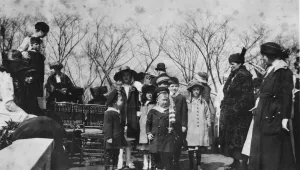"Welcome Home Heroes": A Banner Discovery
March 18, 2022
By Julie Ludwig, Archivist
During preparations for the Frick’s temporary move from its historic building at 1 East 70th Street to Frick Madison, closets and cupboards all over the former residence were emptied of their contents for storage, a few still containing items from the Frick family. A cedar closet on the third floor yielded a number of textiles, including draperies, tablecloths, staff uniforms, buttons, and an array of folded flags. Standing out among these was a massive white banner with a red border, measuring 12 feet wide by 18 feet long, with “Welcome Home Heroes” stitched in large, navy-blue letters.
The banner was the key clue that enabled the Frick’s archivists to finally identify a group of uncaptioned and undated photographs from a family album held within The Frick Collection/Frick Art Reference Library Archives. The photos clearly show a large military parade heading north on Fifth Avenue, whose location we could confirm from images of spectators on the roof of 1 East 70th Street and of a street sign showing the intersection of 71st Street and Fifth Avenue (above). However, the date and occasion of the parade had long remained a mystery. The banner and its message, which are only partially visible in one of the photographs (below), provided the missing link needed to identify, describe, and date the photographs more fully.
The banner—now integrated into the Archives’ holdings—dates from March 25, 1919, one hundred and three years ago. On that day, New York welcomed home its 27th Division from World War One with a parade rivaling anything the city had seen in its history. An estimated three million people thronged to view the troops, 20,000 strong, over the five-mile parade route stretching uptown from Washington Square to 110th Street. (This path purposely paralleled the farewell parade two years earlier, in the summer of 1917, when troops about to depart for training marched downtown on Fifth Avenue.) The welcome home parade proceeded in two detachments: The first was composed of several thousand wounded soldiers, many still visibly bandaged and some waving their crutches, driven mostly by women of the army auxiliary in a line of cars stretching more than a mile. The second comprised soldiers marching in formation behind the New York City police band.
The identification of the large banner and related photographs also led to the discovery of additional documentation, including receipts, correspondence, and a diary entry detailing the Frick family’s participation in the parade. Ten days before the festivities, Henry Clay Frick wrote to newspaper publisher Frank Munsey to suggest publishing his plans to erect a viewing stand at his Fifth Avenue residence for five hundred wounded soldiers unable to participate in the parade, noting: “I suggest this as it might encourage others to do likewise.” Munsey published this information in The New York Sun the following day.
All along the parade route, enthusiastic crowds pressed in from both sides of the avenue, showering the soldiers with confetti, ticker tape, candy, cigarettes, and other tokens of appreciation. The Frick residence was festooned with two hundred yards of garland, seven American flags, the flag of the 27th Division (below, right), and the massive “Welcome Home Heroes” banner. Whether Frick’s newspaper notice had any influence or not, private viewing stands could be found in front of buildings all along upper Fifth Avenue, some raising money for wounded soldiers or to support restorations in Europe. The stand at the Frick house was set up in the Fifth Avenue garden and is identifiable in a handful of photographs (above).
The 1 East 70th Street household diary records that five hundred wounded soldiers from Debarkation Hospital #5 who were unable to march occupied the stand at the Frick residence that day. Mr. Frick’s daughter Helen Clay Frick—who had served in the Red Cross in France during the war—oversaw refreshments for the soldiers, while he and his wife Adelaide watched the day’s festivities either from the dining room windows or from the roof of the house. The diary also notes that during the parade a marching soldier fainted near the Frick residence and was attended to by Burton J. Lee, a Croix de Guerre recipient and the fiancé of Helen’s close friend Louise Freeman, a fellow Red Cross volunteer.
In addition to her role as hostess that day, it is likely that Helen Clay Frick took the photographs from the parade seen above and in the family album. A receipt in the Archives indicates that she also engaged Herbert & Huesgen Co. to film the parade, though the footage has not survived. It is all the more fortunate, then, that the discovery of the banner allowed us at last to identify these images, giving us a glimpse of the ecstatic New Yorkers—the Frick family among them—who welcomed their heroes home more than one hundred years ago.
All photos from The Frick Collection/Frick Art Reference Library Archives, unless otherwise indicated








